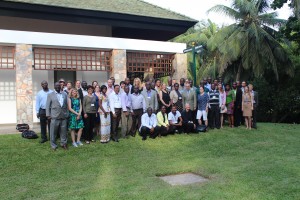Planning for elimination within the USAID NTD portfolio
May 20th, 2015
Most people aren’t very fond of transitions; indeed, some even avoid them. But managers of neglected tropical diseases (NTD) programs aren’t like most people. Not only do they welcome program transitions, they actually seek them out. Why? Because in the world of NTD control and elimination, transitions are powerful signs of program success.

Participants at NTD Partners Meeting on Elimination Planning in Accra, Ghana in April 2015. Credit: RTI International
Successful national NTD programs (NTDP) have to navigate several key transitions. In the case of diseases targeted for elimination (lymphatic filariasis, trachoma and in some countries, onchocerciasis), countries have to make the transition from years of delivering mass NTD treatments to residents of affected health districts, to conducting active post-treatment surveillance, again for a prescribed number of years. During the surveillance period, they have to conduct several nationally representative disease-specific assessments to ensure that the NTDs have not returned. If the country passes these assessments, the NTDP needs to make the transition from active to passive surveillance, while simultaneously preparing a robust dossier for submission to the World Health Organization (WHO) for certification of disease elimination.
Bumps along the road

ENVISION team member Katie Crowley, END in Africa Project Director Bolivar Pou and ENVISION Project Director Lisa Rotondo (left to right). Photo: RTI International
In an ideal world, countries would advance from one transition to the next in a smooth, linear fashion. However, the process is seldom smooth in the real world, for a variety of reasons. For example, many countries struggle to overcome challenges such as disease hotspots, population migration and unexplained persistent disease transmission even after years of mass treatment.
In addition, without extensive investments in water and sanitation infrastructure, disease elimination is not possible for NTDs such as soil-transmitted helminthiasis and schistosomiasis. Realistically, NTDP managers can only aim for disease control in those cases, given the population’s ongoing exposure to disease-causing microorganisms.
At the same time, the path to certification of disease elimination and beyond, still isn’t entirely clear in the case of NTDs such as onchocerciasis. Continuing to present roadblocks are unanswered questions such as, how long is it necessary to continue disease surveillance after stopping mass treatments in order to ensure that the disease will never return? Also, even when countries do manage to reach full disease elimination, they still need to care for the people who continue to experience poor health as a result of disease morbidity.
Creating an end game strategy
USAID’s NTD Program has been working with the teams administering its END in Africa and ENVISION projects for some time to devise and refine an NTD end game strategy. On April 21-23, 2015, FHI 360 and RTI, the respective managers of USAID’s END in Africa and ENVISION projects, co-sponsored a NTD partners meeting in Accra, Ghana, to discuss these and other issues related to elimination planning.
The purpose of the meeting was to improve NTD coordination knowledge and skills in USAID-supported countries on surveillance and processes for verification of elimination of the diseases targeted for elimination (lymphatic filariasis or LF, trachoma, and onchocerciasis). The specific objectives were to:
• Provide an update on progress towards elimination in ten USAID NTD Program countries and identify priority actions for FY 2016.
• Build capacity among national NTDP staff and share information to support the successful implementation of national NTD programs
• Develop recommendations for addressing areas of persistent high prevalence (hotspots), especially in border areas.
In addition to staff from USAID, FHI 360 and RTI International, representatives from the NTD Programs of 10 USAID-supported countries also attended the meeting, including the five END in Africa countries (Ghana, Burkina Faso, Niger, Sierra Leone and Togo) as well as five ENVISION countries (Benin, Haiti, Mali, Nepal and Uganda). In addition, experts from the sub-grantee organizations working those countries (Helen Keller International, Health and Development International, and Interchurch Medical Assistance World Health) attended, as did officials from the Ghana Ministry of Health, Ghana Health Service, the Task Force for Global Health, the United States Centers for Disease Control and Prevention and Deloitte Consulting LLP.
Among the topics they discussed were disease-specific assessments for LF, trachoma and onchocerciasis; strategies for stopping mass treatments; surveillance parameters for all three diseases; procedures for validating elimination dossiers and a review of the WHO’s onchocerciasis elimination guidelines; trichiasis surgery and LF morbidity management; and operations research for the three diseases. After listening to special presentations on persistent LF prevalence and transmission, LF hotspots in Ghana, cross-border collaboration in West Africa, the participants engaged in group discussions on the potential causes of hotspots in each of the 10 countries, and they proposed strategies for addressing those hotspots. A plenary session followed, in which the proposed strategies for addressing LF, trachoma and onchocerciasis hotspots were discussed.
Although many countries in USAID’s NTD portfolio have achieved substantial progress in scaling up mass treatments with sustained good coverage for the targeted diseases (for example, in the five End in Africa countries, 81% of endemic districts [81 out of 100] have stopped mass treatments for trachoma, and 52% of endemic districts [118 out of 225] have stopped treatment for LF), the meeting participants agree that there is still more work to be done. Reaching the NTD end game will require USAID and its partners to develop and implement sound strategies for dealing with hotspots, improving cross-border collaboration and strengthening coordination around NTD elimination and control in USAID-supported countries.

